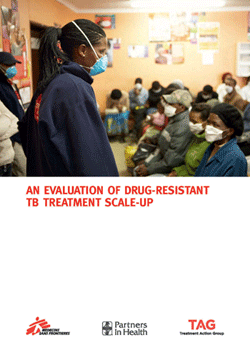July 2011
Globally in 2008 there were an estimated 440,00 cases of incident multidrug-resistant tuberculosis (MDR-TB). Despite international calls for action to reach universal access to TB treatment by 2015, governments and ministries of health in high-burden countries have not adequately progressed with scale-up. According to latest estimates from the World Health Organization(WHO), only 7% of the estimated MDR-TB cases in 2008 were reported (29,423) to WHO, and about 1% of patients were enrolled under programs to provide internationally quality-assured treatment. Of the 27 countries considered to have a high burden of MDR-TB, only 13 reported treatment outcomes.
In May 2009, the World Health Assembly adopted a landmark resolution calling on all 193 member states to urgently scale up treatment and control of drug-resistant tuberculosis (DR-TB). In addition to basic control, the resolution called for the mobilization of domestic and international resources and for countries to remove financial barriers, ensure trained and sufficient human resources, establish a network of laboratories where rapid tests are available, ensure availability of quality drugs, regulate the use of all anti-TB drugs, and introduce infection control measures. According to the WHO, this would require bold and radical policy change.
Despite these political commitments, substantial funding and implementation gaps remain a t both national and international levels. The Stop TB Partnership estimates that US$7.1 billion is needed to treat MDR-TB and another UD$0.3 billion is needed for laboratory strengthening for the period of 2011-2015. The call for a more effective response nationally and internationally could not be more urgent.
In response to these challenges, over the past decade a number of multilateral global initiatives have been established to support drug procurement, laboratory capacity, and monitoring and evaluation of national MDR-TB programs. Chief among these are the Green Light Committee (GLC), the Global Drug Facility (GDF), and the Global Laboratory Initiative (GLI). Established in 2000, 2001 and 2007 respectively, these initiatives are essential elements in the international MDR-TB response architecture. None has been publicly evaluated.
This report, written by Médecins Sans Frontières (MSF), Partners In Health (PIH), and the Treatment Action Group (TAG) – organizations involved in efforts to increase access to treatment and care for patients with DR-TB – aims to provide an assessment of the effectiveness of some key structures within the global response for MDR-TB, to provide recommendations on how the global response to DR-TB scale-up can be improved, and to examine the results of scale-up activities to date in three key countries. It is meant to be a first step towards greater accountability from countries, international mechanisms and donors, all of whom must work collaboratively to address the substantial barriers to scaling-up MDR-TB treatment. Currently, the GLC and GDF are being reformed to address some of the challenges highlighted in this report. It is hoped that this report will constructively inform the debate about how best to foster the scale-up of DR-TB treatment and prevention.

